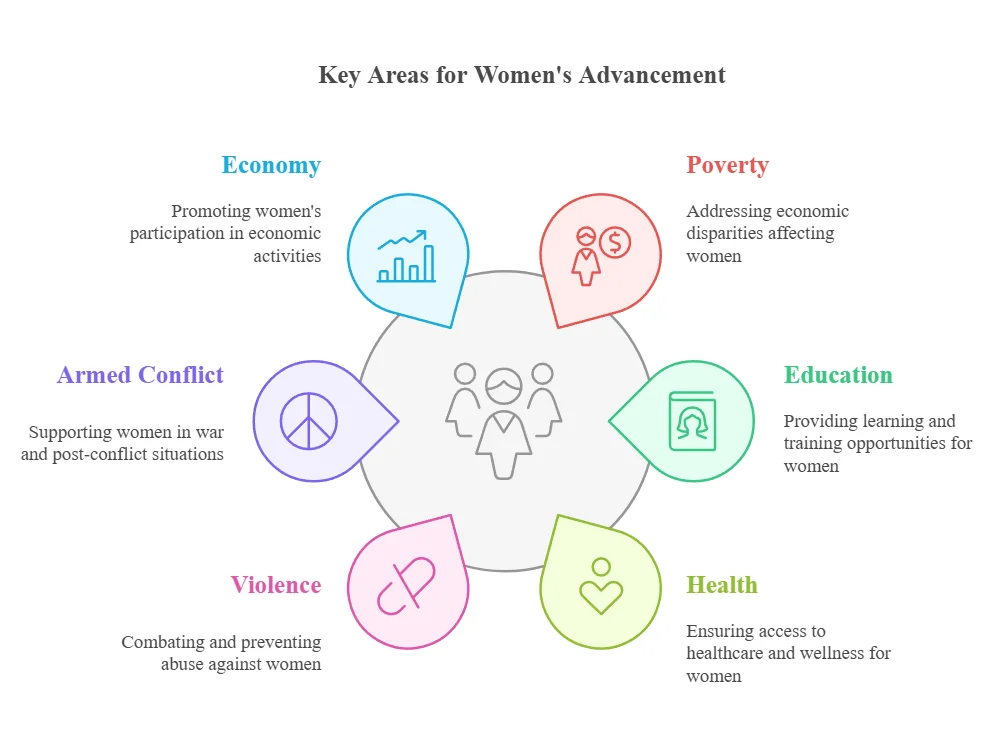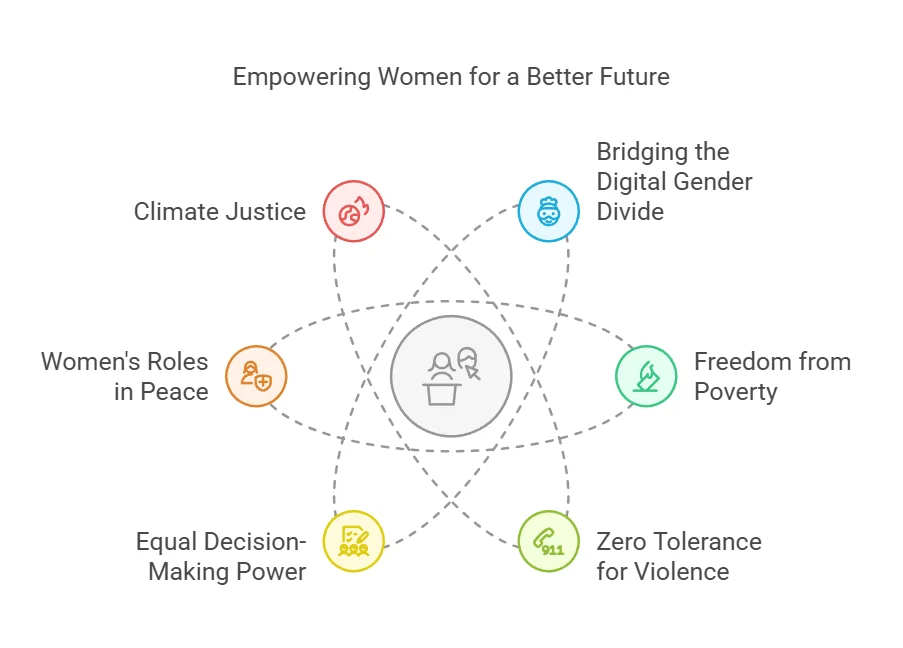UN Women & the Global Gender Agenda | 03 Jul 2025
For Prelims: Beijing Declaration and Platform for Action, UN Women, Food Insecurity, Poverty, UN General Assembly, UN Security Council, NFHS-5, 2019–21, Equal Pay for Equal Work, Paid Maternity Leave.
For Mains: Status of women rights, Challenges associated with women empowerment and way forward.
Why in News?
On the eve of the 30th anniversary of the Beijing Declaration and Platform for Action, the 25th year of UNSC Resolution 1325 on Women, Peace and Security (WPS), and its own 15th anniversary, UN Women warned that women’s rights are facing a “historic and precarious moment” due to rising violence, deepening poverty, and increasing digital and political exclusion.
What are the Key Issues Faced by Women as per UN Women?
- Political Backlash & Lack of Representation: In 2024, nearly 1 in 4 countries reported a backlash against women's rights, with women still holding only 64% of the legal rights men have, and 51% of countries restricting women from doing the same jobs as men.
- Additionally, nearly 75% of lawmakers are men, and only 4% of official development assistance in 2021–2022 focused on gender equality.
- Disproportionate Impact of Violence: In 2023, 85,000 women and girls were intentionally killed, with one killed every 10 minutes by a partner or close relative.
- Between 2020 and 2023, 8 in 10 peace talks and 7 in 10 mediation efforts included no women, reflecting their continued exclusion from peace processes.
- Economic Inequality: Globally, women earn 20% less than men for work of equal value and perform 2.5 times more unpaid care work than men.
- Food and Education Insecurity: 47.8 million more women than men face moderate/severe food insecurity, despite women making up the majority of small-scale farmers who produce 1/3 of the world’s food.
- 119 million girls remain out of school, and 39% of young women don’t complete upper secondary education.
- Climate Vulnerability: By 2050, climate change could drive 158 million more women and girls into extreme poverty, even as women make up only 28% of environment ministers worldwide.
- Poor Health Access: Nearly 800 women die every day from preventable pregnancy-related causes.
Challenges to Women's Empowerment in India
- Low Female Labour Force Participation (FLFPR): India’s FLFPR rose from 23.3% (2017–18) to 41.7% (2023–24) but remains below the global average (50%) and men’s rate (77.2%), limited by societal norms, care responsibilities, and lack of flexible jobs.
- Domestic Burden: Women spend 236 minutes/day on unpaid domestic work vs 24 minutes by men, restricting access to education, skills, and formal employment.
- Gender Pay Gap: Women earn 29.4% less in urban and 51.3% less in rural areas than men.
- 81% work in the informal sector, lacking job security and benefits.
- Digital Divide: Only 54% of women own a mobile phone vs 82% of men, and just 33% have used the internet vs 57% of men (NFHS-5), limiting access to education, jobs, and digital finance.
- Gender-Based Violence: India reported 4.4 lakh crimes against women in 2022, and 29.3% of married women (18–49) faced spousal violence (NFHS-5, 2019–21).
What is the Beijing Declaration and Platform for Action (BPfA)?
- About: The Beijing Declaration and Platform for Action (1995), adopted during the 4th World Conference on Women in Beijing, China, serves as a landmark global framework for advancing the rights of women and girls.
- It outlines strategic objectives focused on legal protection, access to essential services, youth engagement, and driving social transformation.
- India is a signatory to BPfA.
- Areas for Action: The declaration highlighted 12 critical areas requiring urgent attention to achieve gender equality and outlined strategies to ensure equal opportunities for everyone. Key focus areas include:
- Beijing+30 Action Agenda: It marks the 30th anniversary (1995-2025) of the BPfA to review and appraise its implementation. It focuses on six key areas:
UN Women
- Establishment & Mandate: UN Women, established by the UN General Assembly in July 2010, is the United Nations entity dedicated to gender equality and the empowerment of women. Created as part of the UN reform agenda, it merged four pre-existing bodies:
- Division for the Advancement of Women (DAW)
- International Research and Training Institute for the Advancement of Women (INSTRAW)
- Office of the Special Adviser on Gender Issues and Advancement of Women (OSAGI)
- United Nations Development Fund for Women (UNIFEM).
- Core Mission:
- Governance & Leadership: Ensuring women participate equally in decision-making.
- Economic Empowerment: Securing equal pay, decent work, and financial independence for women.
- Ending Violence Against Women: Eliminating all forms of gender-based violence.
- Peace & Humanitarian Action: Increasing women’s role in conflict resolution, disaster response, and peacebuilding.
UN Security Council Resolution on Women and Peace and Security (2000)
- About: Adopted unanimously on 31st October 2000, the Resolution is a landmark legal framework that acknowledges the disproportionate impact of conflict on women and girls and calls for their protection from gender-based violence, including sexual violence.
- Key Pillars of Resolution: It emphasizes women’s participation in peacebuilding, protection from gender-based violence, gender-sensitive conflict prevention, and addressing the specific needs of women and girls in relief and recovery efforts.
What Solutions has UN Women Proposed to Address the Challenges Faced by Women?
- Strengthen Commitment and Leadership: Urges renewed political will, gender-responsive systems, elimination of discriminatory laws, and promotion of women’s leadership, including in climate action.
- Gender-Inclusive Peacebuilding: Calls for greater investment in conflict prevention, women’s participation in peace processes, and improved reproductive healthcare, especially in conflict zones.
- Economic Empowerment: Advocates for equal pay for equal work, anti-discrimination laws, and investment in care infrastructure to ease the unpaid care burden and generate 300 million jobs by 2035.
- Eradicate Poverty and Food Insecurity: Stresses social protection (cash assistance, maternity leave, pensions) and policies to close gender gaps in agriculture and wages.
- Expand Access to Education & Technology: Recommends lowering education costs, offering cash incentives, ensuring safe learning environments, digital access, and online safety, backed by increased public-private funding for gender equality.
Conclusion
Despite global commitments like the Beijing Declaration and UNSC Resolution 1325, women face rising backlash, violence, and exclusion. To achieve gender equality, governments must enforce legal reforms, economic empowerment, inclusive peacebuilding, and climate justice. Stronger political will, funding, and women’s leadership are crucial to reversing regression and ensuring progress.
|
Drishti Mains Question: Examine the barriers to women’s economic participation in India. How can policy interventions address these challenges? |
UPSC Civil Services Examination, Previous Year Question (PYQ)
Prelims
Q. Which of the following gives ‘Global Gender Gap Index’ ranking to the countries of the world? (2017)
(a) World Economic Forum
(b) UN Human Rights Council
(c) UN Women
(d) World Health Organization
Ans: (a)
Mains
Q. Distinguish between ‘care economy’ and ‘monetized economy’. How can the care economy be brought into a monetized economy through women empowerment? (2023)
Q. “Empowering women is the key to control population growth”. Discuss. (2019)
Q. Discuss the positive and negative effects of globalization on women in India? (2015)
Q. Male membership needs to be encouraged in order to make women’s organizations free from gender bias. Comment. (2013)


